By now, the suburbs’ origin story seems familiar. In the mid-twentieth century, the federal government and its chosen mass developers, like Levitt and Sons and American Home Builders, plowed colossal financial resources and political will into building new towns across the country. Each was situated beyond city boundaries and was accessible primarily by cars navigating freshly laid highway asphalt. The developers divided suburban towns into fractions of an acre. On each sat a freestanding house designed for two parents and two or more children, a lawn to show a neat face, and a driveway for a car manufactured by General Motors, Ford, or Chrysler. The suburbs tied these standard model homes and families to strong local schools. Together, modest shelter, steadily increasing in value, and favorable education promised flourishing futures for both parents and children. For the young, white families who were able to access low-cost mortgages that subsidized their moves, the clapboard and concrete sealed in the promise.
Of course, the suburbs never delivered the sanctuary they pledged, even for those people they were supposed to favor, and less so with each passing decade. This well-recognized slippage between suburbia’s polished surface and its dark emotional core itself spawned a film genre that flourished in the 1990s and early 2000. Those movies erupt in horror, disgust, or dark humor as they peer through the suburbs’ fraying assurances. Early in American Beauty, 2000’s best picture and best screenplay Oscar winner, beleaguered wife and real estate agent Carolyn Burnham (played by Annette Bening) strips off her tailored beige power suit to squeegee grimy windows, dispel dust bunnies, and buff worn kitchen tile, all while intoning her mantra, “I will sell this house today!” When, plaster-smiled, she greets her potential purchasers—a mixed white-Asian couple, a Black couple, and a lesbian couple—they slide secret sideways glances, stare perplexedly, and outright demand that Carolyn justify the illusion she is struggling to sell them.
Although Benjamin Herold, a long-time education reporter, might be surprised to find himself cast alongside director Sam Mendes and writer Alan Ball, he likewise wrestles with the suburbs’ treachery in Disillusioned: Five Families and the Unraveling of America’s Suburbs. Through beautifully layered reporting, Herold argues that time and demographic change have created a novel disenchantment. The suburbs are now a trap. The new suburbanites of the twenty-first century are often families of color forced to live inside a crumbling American dream. Disillusioned teaches us about the pain and anxiety these suburbanites face as vaunted public schools undercut their children and the promised increases in home values don’t materialize. Where the films often focus on the long psychological con of mid-twentieth-century abundance, Herold shows how today’s suburban scam snares residents in the material degradation of aging homes and deteriorating infrastructure, as well as the social animus of unfriendly schools and racism from neighbors and town leaders. Both were built in from the beginning.
